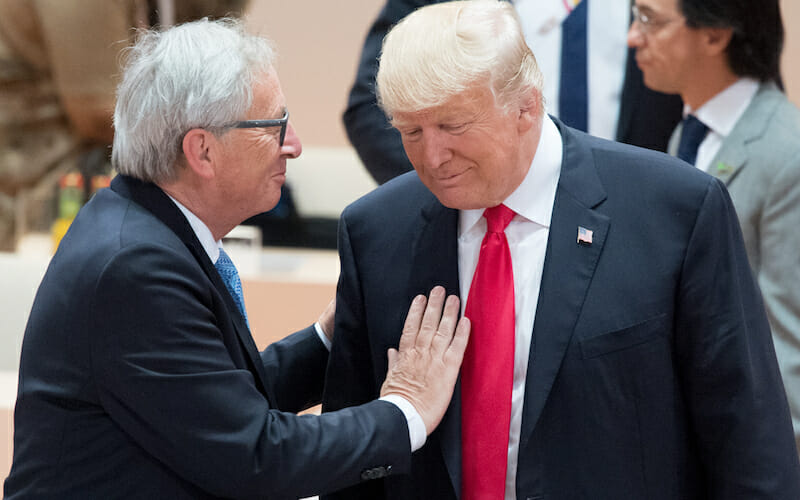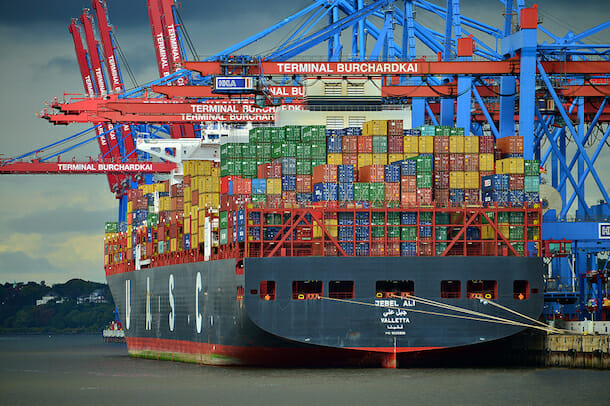
The U.S.-China Trade Standoff Could Blow Out of Proportion
In a trade war through tariff increases, the side with a trade surplus starts out with a major disadvantage. It is a matter of simple arithmetic: the country that sells more can see its export sales slashed more than those of its rival.
This is one of the arguments that so-called trade hawks have invoked to support the tariff increases that the Trump administration has imposed on Chinese goods with the purpose of fighting China’s dubious trade and technology-acquisition practices. Last year, China’s exports to the U.S. amounted to $505 billion, nearly four times as much as what it imported from the U.S. at $130 billion.
That mathematical truism does not mean that the U.S. will come out with a net gain from its standoff with China. Indeed, U.S. consumers will see their purchasing power diminished by the higher prices they will have to pay for goods imported from China. Likewise, U.S. firms will be paying higher prices for the inputs they import from China; their production costs will rise accordingly, eroding those firms’ international competitiveness and eventually forcing them to carry out layoffs.
What is more, tariff increases on Chinese goods will not bring production to the U.S. Indeed, to avoid being affected by the tariff rises, firms operating in China likely will prefer to shift production to third, cheap-labor countries (India, Mexico, Indonesia and South Korea come to mind), rather than to the U.S., where wages are higher.
Thus, if the past is any indication of the future, the steel tariffs levied by Bush administration in 2002 carried a loss of 200,000 jobs.
Those adverse consequences notwithstanding, tariff rises could prove to be an effective tool at the disposal of a deficit country (in this case the U.S.) to press upon the surplus competitor to accept to revise its contentious practices.
The promise of a revision of trade practices following tariff threats is actually what President Trump obtained from the European Commission President Jean-Claude Junker. For sure, the prospective U.S.-EU negotiations may end in a blind-alley, but in any event Trump’s tariff threats have led the EU to realize that time has come to seriously consider U.S. concerns.
Confronted by actual tariff increases against their country’s exports (and not merely to tariff threats as in the case of the EU), China’s authorities have thus far adopted a tit-for-tat strategy. Not only have they been raising tariffs on goods imported from the U.S., but also, and more importantly, they have extended the clash to a terrain which they believe will do more harm. That terrain is none other than the investment front, where they are punishing American firms both through formulating stricter foreign investment rules and through toughening their stance on mergers and acquisitions involving U.S. firms.
China’s decision to withhold their approval to – in fact scuttle – the attempted $44 billion acquisition of Dutch chipmaker NXP by the U.S. giant firm Qualcomm reflects their determination to make life difficult for U.S. technology in retaliation for Trump’s tariff increases.
By taking the fight to the investment front, China may be opening a Pandora’s box. The reason: not only the U.S. but also the UK and Germany are hardening the conditions, on national security grounds, for the acquisition by Chinese state-owned enterprises of firms located in their respective countries. Consonant with its tit-for-tat approach, Beijing has expanded the range of foreign investment projects to be scrutinized by China’s security review process, thereby raising the hurdle to foreign investment in general not only from the U.S.

It seems awkward, indeed incoherent, that Beijing tightens the cap screws on foreign investment overall at the same time that it is trying, unsuccessfully thus far, to reach out to Europe so as to form a common front against Trump’s tariff threats. True, Beijing has been giving priority access to European and Asian companies wanting to invest in China, to the detriment of U.S. firms; thus far, however, as asserted by Zhu Ning at Tsinghua University, it is not sure that the West is buying that.
China’s contradictory and potentially self-damaging moves in the investment field are not the only sign that Beijing is lacking a coherent strategy to take on Trump’s tariff war. Here is another example: China’s authorities initially announced that U.S. crude oil figured among the goods targeted for the next round of retaliatory tariff increases, only to later realize that their country is too dependent on U.S. crude oil and, as an afterthought, removed that commodity from their target list.
This somewhat erratic behavior has all too naturally nurtured doubts, both among Chinese political analysts and within the CCP itself regarding whether Xi Jinping is applying the right strategy to confront the U.S. The malaise has been brought out in a wide array of newspapers and media sites that include the Financial Times, The Washington Post, The New York Times and Bloomberg. Political analyst Jerome A. Cohen, writing in The Washington Post, emphasizes that “there are increasing signs that Xi’s apparently untrammeled power is confronting quiet but growing resistance at home.”
Xi Jinping seems to feel the danger. Hence the recently-announced talks between mid-level delegations of the two countries as well as the road map that Chinese and U.S. negotiators have agreed upon to try to resolve the trade dispute by November – ahead of two summit meetings that Xi Jinping and Donald Trump will attend.
As reported by the Wall Street Journal, “Xi has instructed lieutenants to try to stabilize the bilateral relationship as soon as possible, according to advisers to the Chinese government.” Trump, on his part, keeps blowing hot and cold by giving his green light to those talks while still menacing more than double tariffs on $200 billion worth of Chinese goods.
Tensions may finally be defused should a Trump-Xi encounter (akin to those held by Trump with EU Jean-Claude Juncker and with North Korea’s Kim Jong-Un) take place. Given Trump’s tendency to raise the stakes before settling for pledges obtained from his counterpart at a summit meeting, this cannot be ruled out.
And yet, the worst – i.e. a protracted, major confrontation between the U.S. and China – is still possible, if only because Xi Jinping may fear that, if he ceded to Trump’s stern demands, he would lose face and, as a result, put his leadership at stake. Xi may thus prefer to hold firm against Trump’s pressure and move the standoff beyond the economic domain.
To be precise, Xi might try his luck in the geopolitical terrain. Why not spook the U.S. by amplifying the diplomatic and military encirclement of Taiwan and/or doubling down on Beijing’s attempts to control the South China Sea? This is a scenario depicted, in separate instances, by Cary Huang, a senior columnist at South China Morning Post, Ali Wayne, a policy analyst at the Rand Corporation, and Ren Zeping, chief economist at China Evergrande Group.
China’s recent initiative to oblige service companies (notably airlines, hotels and tourist chains) to treat Taiwan as part of China, and to use the checkbook to induce the score of countries that still have diplomatic ties with Taiwan to break such ties, are steps in that direction. And so is China’s intensified pressure on members of ASEAN (Association of South East Asian Nations), notably Vietnam and the Philippines, to prevent them from independently carrying out drilling projects in the South China Sea.
Whether the current U.S. administration will remain passive vis-à-vis China’s increased geopolitical boldness, or will instead try to roll back Beijing’s moves, forcefully if need be, remains to be seen. The fact is that the tariff war is bringing the two countries close to an uglier showdown.
If worse comes to worse, the current U.S. president can hardly be blamed for taking on China’s trade, technology-acquisition and currency-tinkering practices. Even some of Trump’s usual critics – such as Fareed Zakaria – accept this point. In the same vein, The Washington Post’s Jackson Diehl, while finding fault with Trump, acknowledges that “a bit more use of [U.S.] leverage with this generation of unhinged rulers [who include Xi] might save the world a good deal of future trouble.”
As a matter of fact, in the search of responsibilities for an eventually abrasive U.S.-China showdown, it would be more appropriate to look toward Trump’s predecessors (in plural) for having remained passive, indeed acquiescent, to China’s longtime questionable practices.
A special mention ought to be made to Trump’s immediate predecessor. Indeed, Obama’s failure to enforce his own red line on the use of chemical weapons in Syria, and not the least his inconsequential reaction to Beijing’s refusal to abide with the ruling of the International Tribunal of the Law of the Sea against China’s occupation of seven atolls in the South China Sea, tragically devalued the credibility of U.S. foreign-policy commitments. Such passiveness served to embolden the Chinese leadership, which, understandably, came to believe that it could do as it pleased without risking a commensurate riposte from the U.S.
For all these reasons, the current U.S. reaction to China’s trade, currency-tinkering and technology-acquisition practices was, more than anything else, long overdue.

